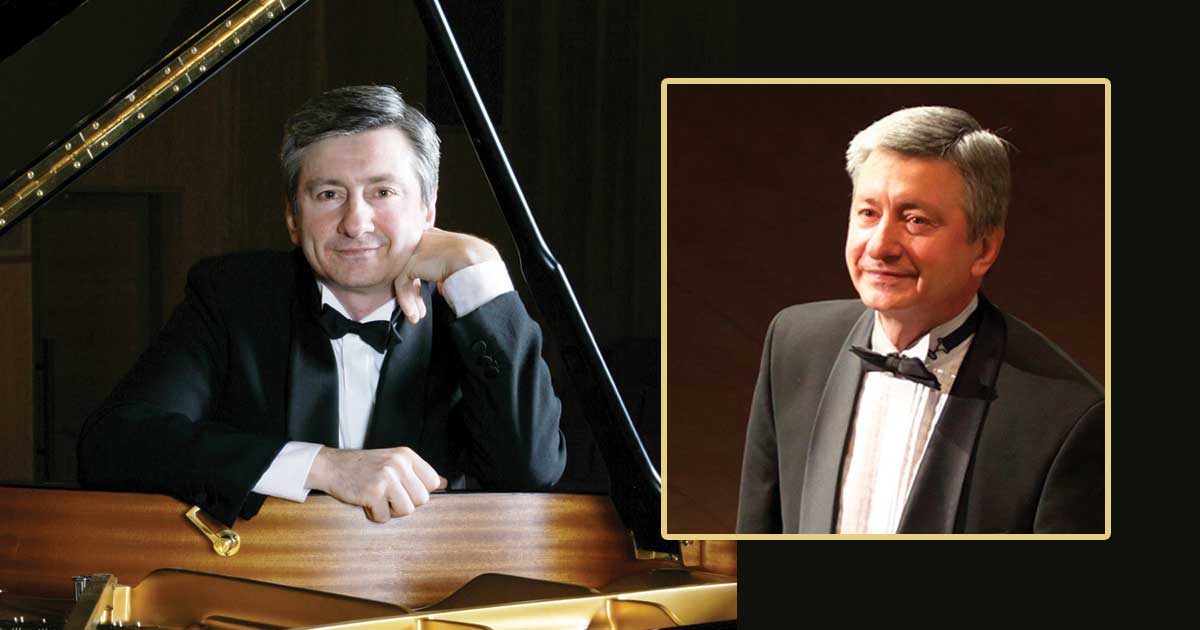
A visa delay has prevented Vladimir Ovchinnikov from traveling to the U. S. in October. For our October 13 concert we are pleased to announce that Jon Nakamatsu and Jon Manassee, the highly acclaimed piano/clarinet duo, will be appearing. Click here for more information. Seats for all ticket holders remain the same for the Manasee Nakamatsu Duo.
(As a courtesy, we are allowing ticket holders to exchange Vladimir Ovchinnikov tickets for another concert this season. Please send the request to office@steinwaysociety.com.)
About
A great maestro. The only pianist to win the top prize at both the International Tchaikovsky and the Leeds Competitions. Ovchinnikov has given triumphant performances in the presence of Queen Elizabeth II and on the world’s top stages.
Vladimir Ovchinnikov is now a professor at the Moscow Conservatory and Artistic Director of the Association of Tchaikovsky Competition Stars. Steinway Society is proud to be able to host this great pianist and bring him back to the San Francisco Bay area.
Bay Area notable Temirzhan Yerzhanov will be presenting a pre-concert lecture about the music from 6:45 to 7:15 p.m, Yerzhanov is a Schumann International Competition First Prize winner, a conductor and educator, distinguished member of the Community School of Music and Arts faculty, Artistic Director and Founder of the Orchestra Gradus ad Parnassum.
Program
- F minor (Allegro non troppo)
- C major (Allegro)
- C minor (Grave)
- D minor (Moderato)
- E-flat minor (Non allegro–Presto)
- E-flat major (Allegro con fuoco)
- G minor (Moderato)
- C-sharp minor (Grave)
- “Lilacs,” Op. 21, No. 5
- “Daisies,” Op. 38, No. 3
- “Do Not Grieve for Me,” Op. 14, No. 8
- “Where Beauty Dwells,” Op. 21, No. 7
- “O, Cease Thy Singing,” Op. 4, No. 4
- “In the Silent Night,” Op. 4, No. 3
- “Floods of Spring,” Op. 14, No. 11
Program Notes
Composed in 1911 at Rachmaninoff’s Ivanovka estate, the Études-Tableaux Op. 33 are highly idiosyncratic explorations of pianistic textures and sonorities. Rachmaninoff regarded these works, though not strictly programmatic, as “musical evocations of external visual stimuli.”
- F minor: Seemingly a march, but peppered with metric irregularities, the opening étude-tableau harks back to Chopin’s A-minor Etude Op. 25 No. 4 in juxtaposing a staccato bass with a sustained soprano melody.
- C major: This étude-tableau features a soaring melody over a pulsating accompaniment in open harmonies (chords covering an octave or more). The beautiful coda closes with radiant trills.
- C minor: A richly textured elegy transitions to a weightless dreamscape in C major, its wide-open harmonies conjuring infinite calm.
- D minor: A fanfare on open fifths becomes the motivic germ.
- E-flat minor: This étude-tableau is sometimes nicknamed the “Snowstorm.” Its swirling triplets and pizzicato-like accents make it quite technically difficult.
- E-flat major: Like the D-minor étude-tableau, this piece begins with a fanfare, though the work’s mood is significantly brighter.
- The G minor is an elegiac nocturne whose placid surface is ruptured halfway through by a swirling cadenza.
- C-sharp minor: Like a prophet proclaiming the apocalypse, the final movement of the Op. 33 Études-Tableaux is declamatory and defiant.
Rachmaninoff’s Second Piano Sonata (1913) is tightly constructed; its first four measures contain the germ for the thematic material that saturates the work. In those opening moments, a headlong cascade into the depths of the bass register is followed by two chords that ring out like a thunderclap, along with a distinctive chromatically descending motif accompanied by turbulent figuration. The rest of the Allegro agitato is a revelatory working-out of those fragments. The exposition’s secondary theme, for example, is a transformation of the chromatically descending motif.
A Non Allegro transition bridges the first and second movements. In the Lento, gently rocking figurations give way to passionate declamations: as the texture thickens, the first movement’s chromatically descending motif is presented in quicker time and diminution across every register of the keyboard, devolving into frenetic repetition of the motif before collapsing in on itself.
Another Non Allegro transition sets up the finale, which opens with an energetic reimagining of the thematic précis of the first movement. Rachmaninoff presents a richly harmonized secondary theme that returns in a triumphant coda.
Rachmaninoff composed his Op. 21 songs (1902) while on honeymoon with his wife, Natalia. The publication helped pay for their travels. In 1914 he arranged perhaps the most famous song in the set, “Lilacs,” for solo piano, enveloping the vocal line with rich bass and shimmering figurations.
The songs of Op. 38 (1916) are the last of Rachmaninoff’s 85 works for voice and piano. He composed no songs after emigrating from Russia in the wake of the Revolution. In the ravishingly beautiful “Daisies,” Rachmaninoff’s solo piano transcription elevates the keyboard roulades from accompaniment to star of the show.
American virtuoso pianist Earl Wild augments Rachmaninoff’s songs with thick, dramatic textures more characteristic of Rachmaninoff’s solo piano music than his vocal works. Wild’s treatment is particularly effective in magnifying the sentiments of a pathos-laden song like “Do Not Grieve for Me” or the overt passion of “Floods of Spring.”
Often, Wild’s transcriptions add entirely new expressive dimensions to Rachmaninoff’s songs. His swirling figurations in “Where Beauty Dwells” create a fervent atmosphere miles away from the placid wistfulness of the original. Instead of preserving the understated simplicity of Rachmaninoff’s youthful Op. 4 songs “O, Cease Thy Singing” and “In the Silent Night,” Wild sprinkles the music with unceasing chromatic harmonizations, countermelodies, and virtuosic runs.